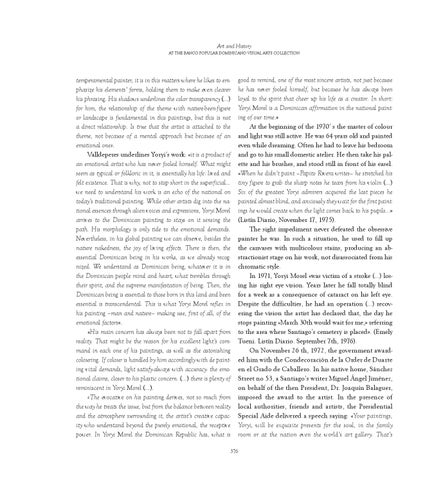Art and History at the Banco popular dominicano visual arts collection
temperamental painter, it is in this matters where he likes to emphasize his elements’ forms, holding them to make even clearer his phrasing. His shadows underlines the color transparency (…) for him, the relationship of the theme with nature-been-figure or landscape is fundamental in this paintings, but this is not a direct relationship. Is true that the artist is attached to the theme, not because of a mental approach but because of an emotional one». Valldeperes underlines Yoryi’s work: «it is a product of an emotional artist who has never fooled himself. What might seem as typical or folkloric in it, is essentially his life: lived and felt existence. That is why, not to stop short in the superficial… we need to understand his work is an echo of the national on today’s traditional painting. While other artists dig into the national essences through alien voices and expressions, Yoryi Morel arrives to the Dominican painting to stays on it sensing the path. His morphology is only tide to the emotional demands. Nevertheless, in his global painting we can observe, besides the nature nakedness, the joy of living effects. There is then, the essential Dominican being in his works, as we already recognized. We understand as Dominican being, whatever it is in the Dominican people mind and heart, what trembles through their spirit, and the supreme manifestation of being. Then, the Dominican being is essential to those born in this land and been essential is transcendental. This is what Yoryi Morel reflex in his painting –man and nature– making use, first of all, of the emotional factors». «His main concern has always been not to fall apart from reality. That might be the reason for his excellent light’s command in each one of his paintings, as well as the astonishing colouring. If colour is handled by him accordingly with de painting vital demands, light satisfy-always with accuracy- the emotional claims, closer to his plastic concern. (…) there is plenty of reminiscent in Yoryi Morel (…). «The evocative on his painting derives, not so much from the way he treats the issue, but from the balance between reality and the atmosphere surrounding it, the artist’s creative capacity who understand beyond the purely emotional, the receptive power. In Yoryi Morel the Dominican Republic has, what is
good to remind, one of the most sincere artists, not just because he has never fooled himself, but because he has always been loyal to the spirit that cheer up his life as a creator. In short: Yoryi Morel is a Dominican affirmation in the national painting of our time.» At the beginning of the 1970’ s the master of colour and light was still active. He was 64 years old and painted even while dreaming. Often he had to leave his bedroom and go to his small domestic atelier. He then take his palette and his brushes, and stood still in front of his easel. «When he didn’t paint –Papito Rivera writes– he stretched his tiny figure to grab the sharp notes he tears from his violin (…) Six of the greatest Yoryi admirers acquired the last pieces he painted almost blind, and anxiously they wait for the first paintings he would create when the light comes back to his pupils…» (Listín Diario, November 17, 1975). The sight impediment never defeated the obsessive painter he was. In such a situation, he used to fill up the canvases with multicolour stains, producing an abstractionist stage on his work, not disassociated from his chromatic style. In 1971, Yoryi Morel «was victim of a stroke (…) losing his right eye vision. Years later he fall totally blind for a week as a consequence of cataract on his left eye. Despite the difficulties, he had an operation (…) recovering the vision the artist has declared that, the day he stops painting «March 30th would wait for me,» referring to the area where Santiago’s cemetery is placed». (Emely Tueni. Listín Diario. September 7th, 1976). On November 26 th, 1972, the government awarded him with the Condecoración de la Order de Duarte en el Grado de Caballero. In his native home, Sánchez Street no 53, a Santiago’s writer Miguel Ángel Jiménez, on behalf of the then President, Dr. Joaquín Balaguer, imposed the award to the artist. In the presence of local authorities, friends and artists, the Presidential Special Aide delivered a speech saying: «Your paintings, Yoryi, will be exquisite presents for the soul, in the family room or at the nation even the world’s art gallery. That’s
376
